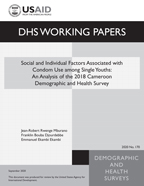- PUBLICATIONS
- JOURNAL ARTICLES
- ACCESS PUBLICATIONS
Publications Summary
- Document Type
- Working Papers
- Publication Topic(s)
- Youth
- Country(s)
- Cameroon
- Survey
- Cameroon DHS, 2018
- Language
- English
- Recommended Citation
- Rwenge Mburano, Jean-Robert, Franklin Bouba Djourdebbe, and Emmanuel Ekambi Ekambi. 2020. Social and Individual Factors Associated with Condom Use among Single Youths: An Analysis of the 2018 Cameroon Demographic and Health Survey. DHS Working Paper No. 170. Rockville, Maryland, USA: ICF.
- Download Citation
- RIS format / Text format / Endnote format
- Publication Date
- September 2020
- Publication ID
- WP170
Download
 Social and Individual Factors Associated with Condom Use among Single Youths: An Analysis of the 2018 Cameroon Demographic and Health Survey (PDF, 408K)
Social and Individual Factors Associated with Condom Use among Single Youths: An Analysis of the 2018 Cameroon Demographic and Health Survey (PDF, 408K)
Download this publication
There is no printed copy available to order.
